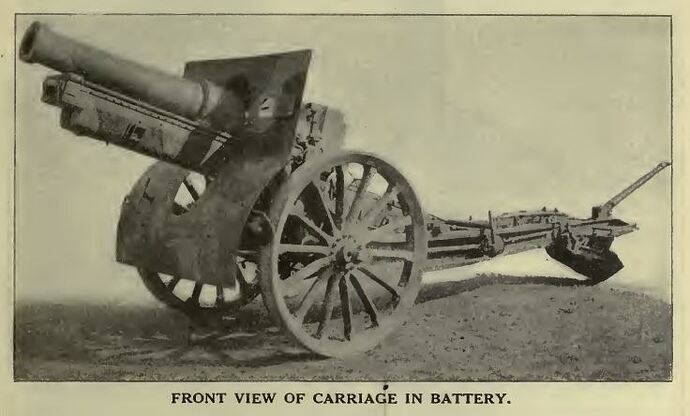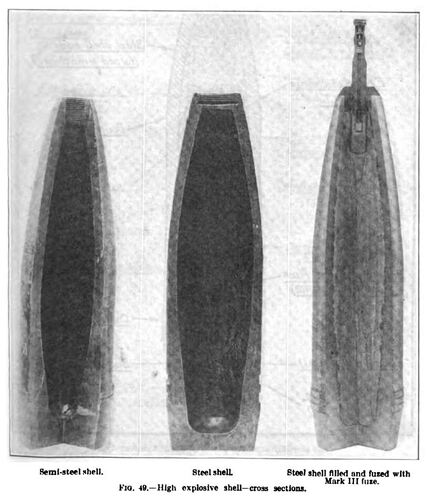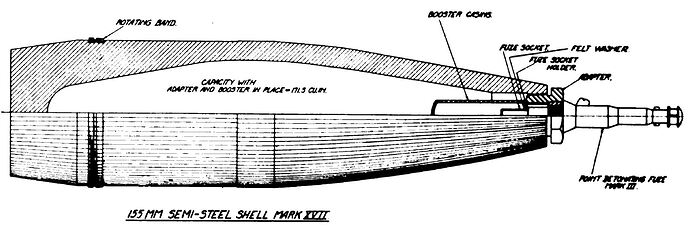Here’s a nice WWII color photo of an ammo dump in England for some color and marking reference
Which bolsters what I’ve said ad nauseum in similar threads. It depends on the time frame you’re depicting. That color scheme was used prior to 1943. It then changed to the olive drab with yellow markings that we know today,
You really have to pin it down to a certain period. Artillery pieces that have very long service lives usually also see incremental and even revolutionary changes in their ammo and propellants over that service life.
The US M1 (M114) 155mm howitzer has been in continuous service since 1942. It is still in service around the world with a number of militaries. Manufacturers constantly develop new ammunition and propellants to improve the performance of these guns. The original M1 155mm was itself an evolutionary development of the French designed Model 1917 Schneider, so the M1 was actually firing ammunition manufactured for the older gun when it was first introduced into service.
There are quite literally dozens of different rounds that are compatible with it. You’re looking at a service life for the M1 155mm (including the ammunition) right now that has spanned well over a century. If you anticipate that the older ammunition can be fired in the newer western power 155mm howitzers, like the M198 and probably even the M777, the service life of the original 155mm ammunition might well continue into and over a second century.
Of course, many of the newer high performance and extreme range ammunition types cannot be fired from the M1 (M114) 155mm howitzer. So, again, more precision in the terms of eras, periods, and locations is really needed to answer the question.
1 Like
I wonder how many years it took before all of the yellow painted rounds that had been produced were either fired up, or dumped at sea, etc., and out of the inventory?
1 Like
I’ve fired some OLD ass 105 ammo back in '98, but the need to fire fire it in wartime has not been nearly as urgent as it was back in WWII. I don’t imagine old stocks of HE went unfired for very long back in WWII, but it’s possible. What gets me though, is whenever someone asks the color of WWII HE projos, the stock answer you get is OD with yellow markings, when it clearly was not during the early years of the conflict.
So yes, you could see yellow projos after 1943, but you wouldn’t see the OD ones in '42.
1 Like
Those are Mk I projectiles for Schneider howitzers.
Usable ammunition was generally reconditioned after the war, so if a sufficient quantity remained to make lotting practical, it would have been repainted.
KL
I’ve been in the field in Petawawa when the artillery was firing into the impact zones. Boy oh boy does it ever make the ground shake for miles around. I did security for my regiments mortar course qualifying shoot in Meaford when the Canadian infantry still had the mortar tasking in the mid eighties. Watching a live shoot of HE and white phosphorus rounds is quite cool. At night watching the flares and their shoot is quite impressive. It’s always nice to have some pocket artillery close at hand. I trained on the 60 mm as a non bipod mount so you had a trigger at the bottom of the tube, we never live fired them but had to cart them around with all the other equipment we carried back then
1 Like
if your talking 155mm bore the rounds are pretty much the same. They can be longer or even shorter, but for the most part will work, The only 155mm cannon I know of is the “long tom” used in WWII and Korea, and the projectile itself is similar. The newer 155 rounds have a slightly different shape and probably length (the newer stuff works off the secant ogive theory). Still it will fit inside the bore of an older gun and is actually spun by the driving band on the outside surface of the round. Rifling twist might not be fast enough (or slow enough) but should still fire. I can’t say much about powder charges as the long tom probably used a slower burning powder charge to make better use of the added barrel length. Still could be wrong about them just as well. The new howitzers use a different powder charge from the looks of it, so can’t truthfully answer that as well.
gary
always wonder what it was like to actually hold onto the tube while firing a mortar. They did it against me on an almost daily basis (82mm and 60mm), and still can’t get a hold on the concept.
gary
Prior to the first of May 1968, I shot 155 ammo made in 1944 and 1945 everyday. We finally ran out (or somebody else got it dumped on them). They were all HE and painted standard O.D. green. What was inside the in 1944 I just have no idea, but ours were filled with generic TNT. most 105 rounds I saw had Comp. B inside them. What is the difference I’m really not that well versed, but it’s been said the Comp. B is more powerful. With a comparison of killing radius’ I can see that. Don’t remember what was inside an 8" round, but was probably TNT. The 175 gun used Comp. B. Never looked at mortar rounds, so can’t say. Plus I don’t read Chinese and Russian at all.
gary
did they actually use Schneider Howitzers in WWII? I’m asking; cause I don’t know. I don’t think those are U.S. manufactured rounds from the shape of the ogive and the nose plugs are different. Could they be British 4.5" rounds?
gary
I’m thankful that we never fired the 60 that way as it looked to be quite the beast to fire that way. Putting the round in then adjusting your angle based on guesstimate trying not to get hit as you moved the switch that fired it. It was also capable of using a bipod and fixed pin to just hang and fire the rounds but I’ve only seen that setup in pictures
Watching the guys trained on the 81 man could the pump the rounds out. Distance depending upon how much charge was attached to the rounds. I understood the firing process. But sighting it no idea. My buddy went to the mortar platoon an awful lot of math involved in learning to operate without any technology aides. Myself I ended up trained as a small arms instructor, infantry communicator, infantry driver wheeled. So I got to hump the radio or drive trucks depending on the needs.
the newer pieces were designed from the get go for a super charge eight. That charge was an after thought on the M1 and M114 carriage. It will shoot a charge eight, but it’s also kinda hard on it. The charge eight came about with the nukes. Never shot one them, but did see them at Sill. Never saw a nuke round.
Interestingly; I shot a good many rounds thru an M110. The rounds were of course heavy (204lb. each), but saw photos of the long range round shot out of the Newport News once. That round must have been twelve to sixteen inches longer with an almost identical shape to the 175 round shot in the M107 (A secant ogive round). The powder charge was at least 50% longer! That round was said to have a max range of 35 miles (can’t prove it by me).
As for shooting a round designed for something like an M777 in an M114, I’d say good to go until you reach the charge eight stuff. Only issue might be the rifling twist rate being too slow.
(round will not stableize in flight). The M1/M114 twist rate was a little on the slow side, and it didn’t take a lot to mess it up in flight
gary
1 Like
The 60mm is usually shot be sight only, as you literally shooting right out in front of you. The 81mm has better range, and of course works best off a base plate and tripod.
I spent an agonizing month or so in FDC due to some skills I had prior to be snatched up on the street. It was very interesting work, but also very boring. Twelve hours on and twelve off was nice, but the twelve on duty was like thirty six hours! Add to this that 70% of them had no idea what was actually taking place on the guns. I took snide remarks as an insult to my buddies. The straw that broke the camel’s back was during a hot shoot in the rain. They griped about them being too slow (that gun crew was [and still is] the single fastest in the U.S. Military). Shooting in a blinding rain is dangerous, but those guys were warm and dry. Next day I said get me outta here!
gary
1 Like
Yes, worldwide. In the ETO alone almost 41,000 tons of HE shells for the M1918 howitzer were expended.
The rounds were designed by the French in WW I and we made them during and after the war. The nose has an adapter to mount the pre-WW I PD fuze that we copied as the Mk III and developed into the M35, M46, and M47. Nevertheless, our original designs looked similar in that era.
KL
1 Like
Kurt;
Not being derogatory, but I’ve probably loaded 12,000 rounds of HE alone (may be closer to 15K). The rounds we shot looked different. Longer and with a greater arc (radius) on the ogive. Boat tails also were more pronounced. We used 563, 565, and M119 time fuses, and whatever the standard PD fuse number. I shot ammo dated as early as 1944 and also new manufacture.
gary
Well, as we’ve established before, what you saw and did in 1969 may not have been what was done in 1918, 1939, 1945, 1991, or 2003.
The projectiles look like foreign designs because they are foreign designs. Did you read what was posted?
How many of your 12-15000 rounds were fired out of these howitzers?

I’m going to go out on a limb and say zero. Do you think that may be why you don’t recognize these projectiles?
It’s really rich to say, “I’m asking; cause I don’t know [about the subject]” then to immediately come back and challenge the answer based solely on your personal experience: “I’ve probably loaded 12,000 rounds of HE alone (may be closer to 15K). The rounds we shot looked different.”
KL
don’t understand where your coming from, but that’s OK with me. I take it you have doubts about the rounds I’ve loaded; then so be it. I shot a 300+ night every six days with out fail. Ad 75 to 100 rounds per day to that. The normal H&I night was a minimum of 300 rounds, and you still shot a little bit during the day. Don’t have to go to far to reach eight to nine hundred rounds in a week. My unit shot the ammo dump in three spots in country and also the San Francisco dump in 68. By the way a one round zone sweep was actually nine rounds. Then you do it again, but three hundred yards away. Often followed by another zone sweep. Just the nature of the beast. Sometimes you shot a series of two round sweeps and every once in awhile a three rounder. It adds up fast. So doubt if you must, but my knees will argue with you every morning.
glt
Just out of curiosity, how often did you change barrels? And from what gun?..That might make a cool diorama, maybe with an M88 doing the lifting?
1 Like
Where I’m coming from is that your personal experience is irrelevant to judging the appearance of projectiles that were taken out of service about a quarter of a century before you even knew what “155H” meant.
KL
Why don’t we end the measuring contest, put the ruler (micrometer?) away?
Well, as we’ve established before, what you saw and did in 1969 may not have been what was done in 1918, 1939, 1945, 1991, or 2003.
I mentioned earlier I fired ammunition in '98 that was quite old, to me at least. Some lots were from the '60’s, some from the 70’s. That ammo was started development in the 20’s and was pretty much standardized by 1930 or so. And yet, photos I posted last August (that would be 2020) show me firing that same ammo type, in addition to firing it again last month. Similar story with 155 ammo, which has been fairly standard for even longer.
Anyone out there cure cancer lately? Anyone? Anyone?
1 Like




